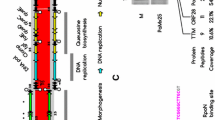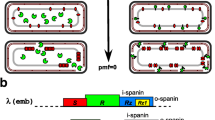Abstract
The phage shock protein (Psp) stress-response system protects bacteria from envelope stress through a cascade of interactions with other proteins and membrane lipids to stabilize the cell membrane. A key component of this multi-gene system is PspA, an effector protein that is found in diverse bacterial phyla, archaea, cyanobacteria, and chloroplasts. Other members of the Psp system include the cognate partners of PspA that are part of known operons: pspF||pspABC in Proteobacteria, liaIHGFSR in Firmicutes, and clgRpspAMN in Actinobacteria. Despite the functional significance of the Psp system, the conservation of PspA and other Psp functions, as well as the various genomic contexts of PspA, remain poorly characterized in Actinobacteria. Here we utilize a computational evolutionary approach to systematically identify the variations of the Psp system in ~450 completed actinobacterial genomes. We first determined the homologs of PspA and its cognate partners (as reported in Escherichia coli, Bacillus subtilis, and Mycobacterium tuberculosis) across Actinobacteria. This survey revealed that PspA and most of its functional partners are prevalent in Actinobacteria. We then found that PspA occurs in four predominant genomic contexts within Actinobacteria, the primary context being the clgRpspAM system previously identified in Mycobacteria. We also constructed a phylogenetic tree of PspA homologs (including paralogs) to trace the conservation and evolution of PspA across Actinobacteria. The genomic context revealed that PspA shows changes in its gene-neighborhood. The presence of multiple PspA contexts or of other known Psp members in genomic neighborhoods that do not carry pspA suggests yet undiscovered functional implications in envelope stress response mechanisms.



Similar content being viewed by others
References
Altschul SF, Madden TL, Schaffer AA, Zhang J, Zhang Z, Miller W, Lipman DJ (1997) Gapped BLAST and PSI-BLAST: a new generation of protein database search programs. Nucleic Acids Res 25:3389–3402
Aravind L, Anantharaman V, Balaji S, Babu MM, Iyer LM (2005) The many faces of the helix-turn-helix domain: transcription regulation and beyond. FEMS Microbiol Rev 29:231–262
Benson DA, Cavanaugh M, Clark K, Karsch-Mizrachi I, Lipman DJ, Ostell J, Sayers EW (2013) GenBank. Nucleic Acids Res 41:D36–D42
Brissette JL, Russel M, Weiner L, Model P (1990) Phage shock protein, a stress protein of Escherichia coli. Proc Natl Acad Sci USA 87:862–866
Cole C, Barber JD, Barton GJ (2008) The Jpred 3 secondary structure prediction server. Nucleic Acids Res 36:W197–W201
Darwin AJ (2005) The phage-shock-protein response. Mol Microbiol 57:621–628
Datta P, Ravi J, Guerrini V, Chauhan R, Neiditch MB, Shell SS, Fortune SM, Hancioglu B, Igoshin OA, Gennaro ML (2015) The Psp system of Mycobacterium tuberculosis integrates envelope stress-sensing and envelope-preserving functions. Mol Microbiol 97:408–422
Edgar RC (2004) MUSCLE: multiple sequence alignment with high accuracy and high throughput. Nucleic Acids Res 32:1792–1797
Finn RD, Clements J, Eddy SR (2011) HMMER web server: interactive sequence similarity searching. Nucleic Acids Res 39:W29–W37
Flores-Kim J, Darwin AJ (2015) Activity of a bacterial cell envelope stress response is controlled by the interaction of a protein binding domain with different partners. J Biol Chem 290:11417–11430
Flores-Kim J, Darwin AJ (2016) The phage shock protein response. Annu Rev Microbiol. https://doi.org/10.1146/annurev-micro-102215-095359
Hutchings MI, Hoskisson PA, Chandra G, Buttner MJ (2004) Sensing and responding to diverse extracellular signals? Analysis of the sensor kinases and response regulators of Streptomyces coelicolor A3(2). Microbiology 150:2795–2806
Huvet M, Toni T, Sheng X, Thorne T, Jovanovic G, Engl C, Buck M, Pinney JW, Stumpf MP (2011) The evolution of the phage shock protein response system: interplay between protein function, genomic organization, and system function. Mol Biol Evol 28:1141–1155
Huynen M, Snel B, Lathe W, Bork P (2000) Predicting protein function by genomic context: quantitative evaluation and qualitative inferences. Genome Res 10:1204–1210
Joly N, Engl C, Jovanovic G, Huvet M, Toni T, Sheng X, Stumpf MP, Buck M (2010) Managing membrane stress: the phage shock protein (Psp) response, from molecular mechanisms to physiology. FEMS Microbiol Rev 34:797–827
Kall L, Krogh A, Sonnhammer EL (2004) A combined transmembrane topology and signal peptide prediction method. J Mol Biol 338:1027–1036
Kleine B, Chattopadhyay A, Polen T, Pinto D, Mascher T, Bott M, Brocker M, Freudl R (2017) The three-component system EsrISR regulates a cell envelope stress response in Corynebacterium glutamicum. Mol Microbiol 106(5):719–741
Koonin EV, Wolf YI (2008) Genomics of bacteria and archaea: the emerging dynamic view of the prokaryotic world. Nucleic Acids Res 36:6688–6719
Korbel JO, Jensen LJ, von Mering C, Bork P (2004) Analysis of genomic context: prediction of functional associations from conserved bidirectionally transcribed gene pairs. Nat Biotechnol 22:911–917
Lassmann T, Frings O, Sonnhammer EL (2009) Kalign2: high-performance multiple alignment of protein and nucleotide sequences allowing external features. Nucleic Acids Res 37:858–865
Manganelli R, Gennaro ML (2016) Protecting from envelope stress: variations on the phage-shock-protein theme. Trends Microbiol. https://doi.org/10.1016/j.tim.2016.11.010
Mascher T, Zimmer SL, Smith TA, Helmann JD (2004) Antibiotic-inducible promoter regulated by the cell envelope stress-sensing two-component system LiaRS of Bacillus subtilis. Antimicrob Agents Chemother 48:2888–2896
Mistry J, Finn R (2007) Pfam: a domain-centric method for analyzing proteins and proteomes. Methods Mol Biol 396:43–58
Nielsen H (2017) Predicting secretory proteins with SignalP. Methods Mol Biol 1611:59–73
Overmars L, Kerkhoven R, Siezen RJ, Francke C (2013) MGcV: the microbial genomic context viewer for comparative genome analysis. BMC Genom 14:209
Price MN, Dehal PS, Arkin AP (2010) FastTree 2–approximately maximum-likelihood trees for large alignments. PLoS ONE 5:e9490
Rogozin IB, Makarova KS, Wolf YI, Koonin EV (2004) Computational approaches for the analysis of gene neighbourhoods in prokaryotic genomes. Brief Bioinform 5:131–149
Soding J, Biegert A, Lupas AN (2005) The HHpred interactive server for protein homology detection and structure prediction. Nucleic Acids Res 33:W244–W248
Sonnhammer EL, Eddy SR, Durbin R (1997) Pfam: a comprehensive database of protein domain families based on seed alignments. Proteins 28:405–420
Sonnhammer EL, Eddy SR, Birney E, Bateman A, Durbin R (1998) Pfam: multiple sequence alignments and HMM-profiles of protein domains. Nucleic Acids Res 26:320–322
Vothknecht UC, Otters S, Hennig R, Schneider D (2012) Vipp1: a very important protein in plastids?! J Exp Bot 63:1699–1712
Vrancken K, van Mellaert L, Anne J (2008) Characterization of the Streptomyces lividans PspA response. J Bacteriol 190:3475–3481
Wattam AR, Abraham D, Dalay O, Disz TL, Driscoll T, Gabbard JL, Gillespie JJ, Gough R, Hix D, Kenyon R, Machi D, Mao C, Nordberg EK, Olson R, Overbeek R, Pusch GD, Shukla M, Schulman J, Stevens RL, Sullivan DE, Vonstein V, Warren A, Will R, Wilson MJ, Yoo HS, Zhang C, Zhang Y, Sobral BW (2014) PATRIC, the bacterial bioinformatics database and analysis resource. Nucleic Acids Res 42:D581–D591
Acknowledgements
This work was supported in part by a grant from the National Institutes of Health (R01AI104615) to MLG. We thank members of the Gennaro and Aravind laboratories for valuable discussions.
Author information
Authors and Affiliations
Corresponding author
Ethics declarations
Conflict of interest
The authors declare that they have no conflict of interest.
Electronic supplementary material
Below is the link to the electronic supplementary material.
Rights and permissions
About this article
Cite this article
Ravi, J., Anantharaman, V., Aravind, L. et al. Variations on a theme: evolution of the phage-shock-protein system in Actinobacteria. Antonie van Leeuwenhoek 111, 753–760 (2018). https://doi.org/10.1007/s10482-018-1053-5
Received:
Accepted:
Published:
Issue Date:
DOI: https://doi.org/10.1007/s10482-018-1053-5




